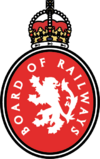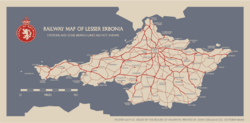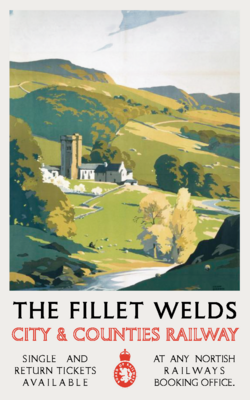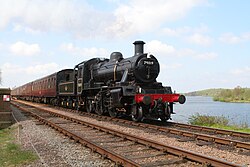Nortish Railways
 | |
| Nortish Railways | |
| Crown office | |
| Industry | Railway transport and logistics |
| Founded | 24 June 1919 |
| Headquarters | , |
Key people | Sir William Gouldon |
| Parent | H.M. Trade Office |
| Subsidiaries |
|
His Majesty's Board of Railways is a department of the Government of Great Nortend which has jurisdiction over public and private railways, established by the Railways Act 17 Edm. IX p. 230. It also is the department in charge of Nortish Railways, the public railway service. The Board began formal operations on Midsummer's Day, June 24th, 1919, after the Railways Acquisition Act was enacted which provided for the consolidation of the existing 87 standard gauge railway companies into eight new regional railways as divisions of Nortish Railways. On Michaelmas of 1920, the former companies, having been stripped of most of their assets, were ,acquired’ by the Crown, vested in the Board.
As of 2019, the public standard gauge (5 ′) railway network spans nearly 22,000 miles of track and 7,358 stations and halts. The Board controls this network in Great Nortend through the eight regional railways which collectively form Nortish Railways. These operate as independent departments of Nortish Railways in the Board of Railways structure. The chairman of the Board is the Master of the Board of Railways, presently the Rt. Hon. Sir William Gouldon, Second Lord of Trade. The position is a Cabinet level ministerial post.
History
Before Collation
Before the Collation in 1919, the railway network was operated by nearly a hundred railway companies in competition with each other. This was highly inefficient and wasteful. In 1913, the Government realised that the railways were an integral public utility necessary for the maintenance of Erbonian society which had become highly dependent on the railways. Royal acquisition was the standard method for securing such public services, as had occurred with the constabularies and fire brigades of the 18th and 19th centuries.
The „Corkton Report” was published in 1915 outlining a plan to completely nationalise the railways which the Sowerton Drougher government took it to the 1916 elections. The elections were won by the Scodeliers, which instead proposed an alternative form of acquisition which collated the companies into eight amalgamated railways, to form independent divisions of the new Nortish Railways ,Company’. Collation as the process was known, was popular with the smaller railway companies, and they were facing bankruptcy with numerous small stations, dense bureaucracy and inefficient staffing. The larger railway companies, however, were opposed to the plans until the Government agreed to grant shareholders immediate compensation to the value of 1·25 times their share price. Subsequently in 1919, the Railways Acquisition Act was enacted.
Collation
In accordance with the Act, the Board of Railways was established by Order in Council on the 1st of July, 1919, taking over the assets of the 87 existing standard gauge railway companies. Senior directors of their component railway companies were mostly all invited to take similar positions within each of the eight new regional railway divisions, which corresponded of the former eight major railway companies. After a transition period of five terms, all assets of the former companies by operation of the Act on September 28th, 1920, Michaelmas, were transferred to the Board of Railways.
Remarkably, the process went quite smoothly as stations, locomotives and rolling stock had already been repainted in their new operating colours as . ,Brand’ unification under Nortish Railways failed, however, to bring about any practical changes to the operation of the railway system until 1933, when the Board of Railways introduced a unified national through-ticketing scheme, known as the Board of Railways Clearing Ticketing System, or „B.O.R.T.S.”
Thitherto, although goods could be sent across companies by a single consignment, passengers wishing to change between trains which were operated by different railways needed to buy separate tickets for each separate leg of the journey. Under the Clearing system, a single, standardised ticket could be used across all services on a single fare, and could be purchased at any booking office under the Clearing system.
Renewal
By the 1970s, the Nortish Railways network had fallen far behind much of the rest of the world in terms of technology. Steam remained the main form of tractive power on the railways, supplanted by electricity on some suburban lines. Furthermore, infrastructure was deteriorating with a lack of funds for maintenance or replacement.
A proposal was tabled by the eight joint railway companies to the Board of Railways in 1972 which proposed the introduction of diesel power to replace steam, which was inefficient and ,dirty’. The cost of the programme was expected to run to the millions of pounds and was rejected by the Bokewell government as being against the national interest.
Instead, the Board of Railways published its own report in 1974. The „Renewal Report” proposed a number of changes which aimed to renew and rejuvenate the Nortish Railways network. These included :—
- Full centralisation with regional divisions replacing semi-independent regional railways
- More unified national identity and stronger travel advertising.
- Investment in new steam locomotive designs with greater efficiency.
- A new standard design of coaches and rolling stock.
- Electrification of more suburban lines.
- New sleeper and cross-country express services.
- Renewal of track and infrastructure, removal of level crossings, and duplication of track.
- Closure of several lines which duplicated existing lines.
- Opening of new regional marshalling yards for goods.
The Renewal Report was accepted by the Cabinet, with the exception of the abolition of the historic regional railways. Instead, greater inter-region harmonisation and co-operation was ordered, starting with a greater prominence placed on the Nortish Railways brand. The traditional „Bramley badge” of Nortish Railways, with the oval, crown and lion, was to be used in conjunction thenceforth with the operating railway's name and badges. Greater livery, stationery, signage and design harmonisation was also implemented, along with a renewed national advertising campaign, headed by the Board of Information.
A significant change was the introduction of the Board of Railways standard designs for railway coaches and rolling stock in 1977, to replace old, worn-out and potentially unsafe stock which mostly dated back to the early and mid 20th century. The new carriage designs accommodated three classes of travel and were available in compartment, corridor and open designs.
Operations
Nortish Railways is controlled on a national level by the Board of Railways, at Railway House in Lendert-with-Cadell. The Board determines national railway transport planning, sets general policies on routes and fares, and coordinates local operations. The head of the Board of Railways is the Master of the Board of Railways, usually a Cabinet-level ministerial position. The real running of the railways is undertaken by eight regional railways, which form independent subsidiary ,branches’ of Nortish Railways. These are the :—
- City and Counties Railway
- Eastern Railway
- Southern Railway
- Medden Railway
- North Central Railway
- North Western Railway
- Cardish Railway
- Hambrian Railway
Each railway, despite forming part of the Nortish Railways „corporation”, has a wide and independent discretion as to how passenger, goods, minerals and other traffic is carried. They are all, however, subject to the orders, policies and control of the Board of Railways.
Technology
Nortish Railways predominantly uses steam locomotive traction for its railway services. The furthering of hot-boiler steam technology has led to improvements in the efficiency and cleanliness of steam engines. Most locomotives run on cleaner anthracite coal or biocoal, which is formed from torrified biomass into lump-sized pellets which have much of the same characteristics as anthracite coal. Some lines, especially the suburban lines, use electric locomotive traction through a third rail, to reduce smoke and noise in densely populated cities. This is only possible in cities where there is a reliable source of electricity.
The main line gauge used is common 5 foot gauge, as this in Catherinian units corresponds to the international 4′ 8½″ standard gauge. There are also some narrow gauge lines, of various gauges.
Buffer and chain couplings are universal on the Nortish Railways network. Passenger and fitted goods stock are fitted with vacuum brakes, air brakes being banned since 1932. They also have screw link couplings, whilst unfitted goods use ,loose’ three link couplings, tensioned by a brakevan at the rear of the train.
The signalling system used by Nortish Railways is based on two aspect semaphore route absolute block signalling. Stopping signals have a striped red-white-red arm, and red and green lenses. Fore signals have a yellow-black-yellow fish-tailed arm, with clear (yellow) and green lenses. Only upper quadrant signals are used, with paraffin lamps and glass lenses. Signals are operated by two wires from manned signalboxes. The interlocking mechanism is rod interlocking, whereby signal and point levers are mechanically interlocked to prevent opposing movements.
Services
Nortish Railways is required by law to carry passengers, post, livestock and most goods, depending on station accomodation. Railway stations on the Nortish Railways network are classified as either high stations, middle stations, stations or halts. High stations are the largest, located in main cities and the largest junction towns. These include the city termini stations. Middle stations and stations are generally located in towns and villages respectively. All stations are fully staffed except for halts. Most stations have a goods yard or sidings, with facilities for the loading and unloading of goods and livestock.
Passengers
Passenger services are available at most railway stations on the network, save for a small number of industrial and goods stations. Under the Railways Act, Nortish Railways (through the regional railways) is obliged to provide at least a twice-weekly service at all passenger stations. Passenger trains are of four main sorts :—
- Stopping trains (stops at halts, stations, middle stations, high stations)
- Through trains (stops at stations, middle stations and high stations)
- Express trains (stops at middle stations and high stations)
- Farren trains (stops at high stations only)
Other trains include specials and excursion trains which run for special occasions. Most sleeper services are farren trains.
Passenger services are available on most lines in three general classes : first class, second class and third class. A station must be served at least twice-weekly by a train with least one compartment in each class. Other trains may or may not have every class of travel; however, most trains excepting labourers', luxury and special trains, have all three classes of travel.
Most trains run with compartment or corridor coaches, where seating is provided in enclosed compartments with a connecting side corridor. Stopping trains, such as rural branch line trains or surburban trains, do not have a corridor, and hence are not „through”. A ticket will not guarantee a seat unless the passenger pays for reservation of a seat on a particular train. Reservation, when available, must occur at least an hour before the train is due to begin its journey, to ensure that it can be processed in time.
Post
Post is an important item carried by the railways on behalf of the Post Office. Both mail and parcels are carried. Post is carried on ordinary stopping or express passenger services for speedy pickup and delivery. Special travelling post office trains allow for the collection, sorting and delivery of post at high speed, allowing for over-night delivery across most of the country.
Livestock
Livestock is normally carried by the railways in special cattle vans, livestock vans and horse boxes. Not all stations handle livestock traffic, and most suburban stations have limited facilities for anything other than horses. Pets and other small animals such as chickens, fish or birds, may be carried in the guard's compartment on most trains.
Goods
Goods form a large part of the carriage load of Nortish Railways. As common carriers, railway companies are obliged to carry „all manner of reasonable goods”. Most goods traffic is waggon-load which comprises nearly two thirds of all goods traffic revenue. Container traffic is very limited owing to the loading gauge, and containers generally are unpacked and unpacked manually at ports, rather than being transported as-is. Around a third of all goods is part waggon-load goods, such as items of merchandise, fresh produce and sundry goods. The rest is bulk ballast, ore, coal, sand, gravel &c.
This page is written in Erbonian English, which has its own spelling conventions (colour, travelled, centre, realise, instal, sobre, shew, artefact), and some terms that are used in it may be different or absent from other varieties of English. |






